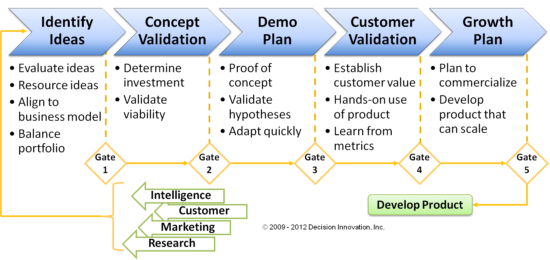Managing change and innovation - Getting the most from the innovation funnel
As complexity increases, managing change and innovation becomes increasingly difficult. Despite (or because of) easy availability of information, the ability to project future outcomes has moved from an environment of manageable risk to rising degrees of uncertainty. The speed at which information is transformed into actionable knowledge is not keeping pace with changes in the business environment.
Manageable risk implies that there is sufficient knowledge to at least quantify the probabilities of specific outcomes. Uncertainty, as characterized by Frank Knight (1921), suggests that the level of risk becomes unknowable. In this type of environment the time to learn becomes the fundamental restriction to effective innovation. New knowledge must be created to determine the changes (or improvements) that will provide benefit and meet goals.
Managing change and innovation to accelerate critical learning
 Innovation inherently requires some level of change. Change requires learning. However, humans and organizations tend to learn as a reaction to events. Business incentives provide additional motivation to exploit existing knowledge. What change triggers will motivate the investment in new learning needed to innovate?
Innovation inherently requires some level of change. Change requires learning. However, humans and organizations tend to learn as a reaction to events. Business incentives provide additional motivation to exploit existing knowledge. What change triggers will motivate the investment in new learning needed to innovate?
Triggers come from both internal and external sources and include:
External triggers
- Customer needs, desires or expectations
- Competitive offers
- New technology
- Changing demographics
- Economic cycle
- Geo-political events
- Environmental change
- Societal change
- Industry structural changes
- Regulation change
Internal triggers
- Decisions
- Problems in operations
- Company growth or decline
- Leadership and personnel change
- Changes to inter-organization alliances
Innovation provides a response to these change triggers. Types of innovation help characterize these responses, suggesting innovation that could provide a more effective response to a specific change environment or trigger. With high uncertainty and possibility, managing change and innovation effectively requires that learning investments be focused on the areas of change that represent the highest risk and/or opportunity for continued sustainability and growth of the business.
Of this long list of change triggers, only decisions come fully under control of the firm. Innovation processes typically include external and internal scanning to provide early identification of change triggers, moving company responses into the strategic decision and innovation funnel.
Manage decision making to reduce resistance
Resistance and challenges to change develop in response to factors that increase emotions in decision making. These include:
- Self-Interest and fear of personal loss
- Lack of trust and understanding, particularly with regard to intentions and purpose
 Uncertainty and lack of information that makes it difficult to project likely future events
Uncertainty and lack of information that makes it difficult to project likely future events- Different goals and assessments by people who will be impacted by a change
Decisions need to be made at every level to support desired change. This implies that people with different decision making styles must get the information, communication and motivation needed to decide to align and respond positively.
Managing change and innovation should also address questions important to business sustainability and growth.
- How much will innovation cost?
- How will it be measured?
- What is the return on innovation?
- Is the cost of failure predictable and acceptable?
- How many of the decisions fundamental to the current business model will need to change?
- What are the likely consequences of a failure to change?
In high uncertainty, the learning investment needed to address these questions becomes difficult to predict, and managing change will need to focus on learning that verifies potential. Stage gates, when used as learning milestones can help manage the learning investment.
Are gated processes still relevant?
When used appropriately, gated processes can provide an effective framework for managing change and innovation. However, gate review boards must represent true decision making bodies. For innovation, they must encourage accelerated, validated learning that reduces uncertainty with minimum investment. Decisions completed at each gate should inherently support the change process needed for the organization to encourage the success of an innovation.
Consider the following innovation gate decisions:

- Idea identification - Ideas are evaluated for further resourcing. Criteria will often demonstrate the ability to be accommodated in the current business model, although spinoffs may be supported. Balance must be developed that will promote promising ideas while preventing being overwhelmed by evaluation of too many ideas.
- Concept validation - The concept is developed enough to determine the investment needed to validate key elements of viability such as value proposition, competitive advantage, and likely returns.
- Demonstration development plan - A plan is developed to provide a proof of concept demonstration to customers. For startups, this could be a product that might be used with non-paying customers. This plan will seek to minimize investment needed to validate key hypotheses with targeted customers. A demonstration vehicle that can accommodate quick and low cost requirements changes will accelerate the learning process.
- Customer value validation - The value to the customer is established through their interactions with the demonstration product. Metrics that show causality will provide the learning that will continue to reduce uncertainty.
- Growth plan - commitment to commercialize - For businesses with an established business model, the plan for full commercialization is developed. This may be the entry business gate to the more predictable (knowable risks) development process. For newer businesses, investment is made to develop a product that can scale as business grows.
Each successive gate in the innovation funnel reduces uncertainty that would prevent additional investment. The decisions made provide evidence of meeting established factors needed for success. Factors that facilitate change are increased while factors that work to resist change are reduced. Needed communication and education are built into the process.
Managing change in the product innovation process
Adapting to uncertain environments with rapid change has encouraged adoption of agile methods in software development. Acceptance of this approach recognizes that cycle times for large scale development have not been able to meet the needs of the current change environment. Learning and adapting to changing priorities has been a key factor in choosing these methods.
Similarly, the effectiveness of managing change and innovation will ultimately be constrained by the limits of an organization's learning and decision making processes. These processes should return more than they cost and facilitate the knowledge creation needed for decision making in uncertain environments.
Return from Managing Change and Innovation to Innovation Management

